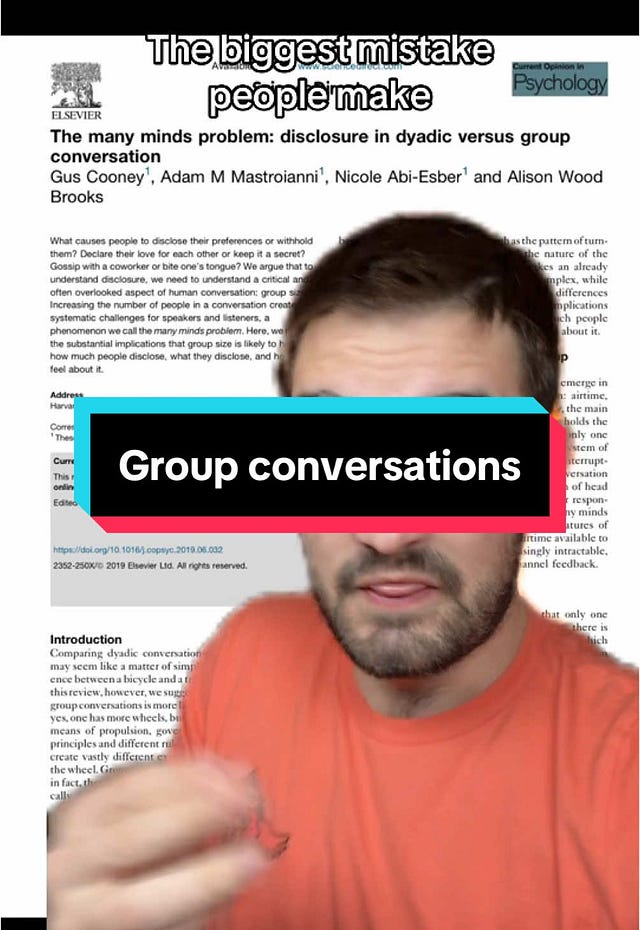Using conversation dynamics to understand three-person scenes
Understanding how conversations flow can help us understand why three-person scenes come with an extra layer of complexity

Good improv scenes are much like conversations in that there’s a flow. When two people are chatting, each is taking in what the other is saying and building on it. There’s no thinking about what to say next or looking to one-up; you’re in it.
This recent TikTok video about group conversations from the Etymology Nerd (who I’ve referenced before in a previous post) stood out to me. I recommend watching it first before continuing, as it’s short and sweet.
If you can’t watch the video, I’m focusing on the opening of it, relating to the roles of ‘talker’ and ‘active listener’. What is said is (emphasis mine):
Every conversation relies on three fundamental mechanics:
Airtime which is how long the speaker holds the floor.
Turn-taking which is how airtime transfers between the speakers.
Back-channeling which is how the listener shows they’re respecting the speaker’s airtime.
Using this framework, you can see some overlap between this and how improv scenes work.
As we’re building one line at a time, the ratio between airtime and turn-taking is usually consistent.
I think the fundamental change is to back-channelling. In the context of improv, showing respect for the other person’s time and contribution isn’t just about taking in what they’re saying but also about building on it.
You can nod or say ‘yes’ to what’s being said to you, which are all valid responses, but we get to go further.
We’re not just speaking and listening; we also check in with each other. We observe the physical actions and poses, what facial expressions are being made, and our position on stage.
Enter the third person
It’s no secret that two-person scenes are the preferred type of scene for performers, as they are much easier to focus on.
When you add a third performer to your scene, the dynamic changes as your attention is now split between two people.
The video above states that while the airtime changes, the split between the three isn’t even. As it’s much harder to achieve an even split, what happens is that two people will get the majority focus, while the third person usually becomes a passive listener.
Scenes with three people usually end up being confusing, as all of them are trying to figure out what the scene is and how to split the focus.
If you start a scene with three people or a third person enters very early, not enough has been established to determine what to focus on, and therefore, the dynamic can take longer to establish.
It can be harder if you have performers who are more dominant (or just louder). They can become the main characters not through the strength of their ideas but by being more forceful or inflexible in how they approach the scene.
Less is more
Assuming you’re in a situation where you haven’t planned for a three-person scene, what do you do?
The general advice improv teachers and coaches give is to treat scenes with three people or more like two-person scenes. That is, divide into two groups.
Two performers share a similar viewpoint, while the other performer’s perspective differs from theirs in some way. It’s easier to keep track of views and keeps the scene focused.
Walk-ons are a little different as the third-person is usually on stage for a short period of time, with the intention of augmenting a character’s behaviour or established premise.
If you’re in a situation where you’re in a scene with pushy or dominant performers, and you’re stuck in the role of third person, the best thing to do is follow the flow.
While this means you have to support by showing restraint, and while that can certainly feel like a thankless task, what’s important to note is that in these situations, doing less is more.
The contrast between their action and your subtly is far greater than we realise, giving the scene an extra layer of subtext.
Sometimes, that doesn’t even mean speaking. It can be physicality by doing actions in the background, or it could be as simple as giving facial expressions anytime someone says something meaningful.
You may not think you’re doing much, but an audience will pick up on it, and when you do speak, there’s greater value placed on it.
It’s useful to think of the scene as a conversation as it will become less about impressing and more about how the scene is being served.
It’s a valuable skill because it adds a different layer of flexibility to your performance. Recognising what dynamic is forming and positioning yourself accordingly to strengthen the scene is a skill all teams need.
If you can spot the moments when being the third person in a scene helps, you can definitely recognise when being the main focus is the better option and adjust accordingly.
Thanks for reading Third Beat. If you like what you read and want more, please subscribe to it via the button below.
If you are a subscriber and are enjoying it so far, support the newsletter by recommending it to a friend or give a donation through Buy Me A Coffee.




Love this! So helpful